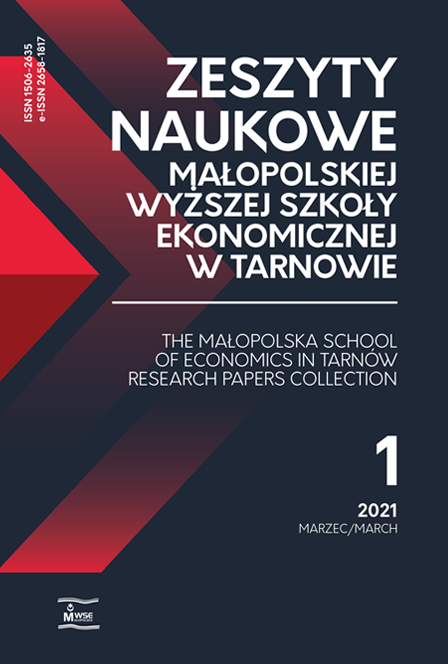Abstract
The purpose of this paper is to verify whether companies listed on the Warsaw Stock Exchange disclose less information about reserves in their financial statements in case of a reduction in reserves than in case of an increase in reserves. It has been hypothesized that in the case of a reduction in reserves balance, disclosures are less detailed than in the case of an increase in them. This hypothesis was verified through an analysis of information reported in the financial statements of 148 companies listed on the Warsaw Stock Exchange for the years 2007–2014: in total, the analyzed data comes from 1184 financial statements. Within the research, a three-step index of disclosures detail of the two leading reserve categories is constructed and followed with a comparison of the values of disclosure indexes and the fact that reserves were reduced and increased. The research methodology included literature studies and empirical studies using the author’s index of disclosure detail and statistical testing. The conducted research extends the cognitive legacy of mainstream research into the quality of financial statements disclosures and in the principal-agent problem.
References
Abou-El-Sood, H. (2012). Loan loss provisioning and income smoothing in US banks pre and post the financial crisis. International Review of Financial Analysis, 25(3), 64–72.
View in Google Scholar
Andrzejewski, M., Mazurczak, A. (2011). Kontrolna funkcja rewizji finansowej w jednostkach zainteresowania publicznego. In: B. Micherda (ed.). Współczesne aspekty realizacji kontrolnej funkcji rewizji finansowej. Warszawa: Difin. ISBN 9788376414447.
View in Google Scholar
Ascioglu, A., Hedge, S. P., Krishnan, G. V., Mcdermott, J. B. (2012). Earnings management and market liquidity. Review of Quantitative Finance and Accounting, 38(2), 257–274. DOI: 10.1007/s11156-010-0225-9.
View in Google Scholar
Bęk-Gaik, B., Walińska, E. (2012). Rezerwy jako istotna kategoria kształtująca wynik finansowy. Zeszyty Naukowe Uniwersytetu Szczecińskiego, 50, 359–374.
View in Google Scholar
Berry-Stölzle, T. R., Eastman, E. M., Xu, J. (2018). CEO overconfidence and earnings management: Evidence from property-liability insurers’ loss reserves. North American Actuarial Journal, 22(3), 380–404. DOI:10.1080/10920277.2017.1421977.
View in Google Scholar
Bleck, A., Liu, X. (2007). Market transparency and the accounting regime. Journal of Accounting Research, 45(2), 229–256. DOI: 10.1111/j.1475-679X.2007.00231.x.
View in Google Scholar
Cheng, J., Cummins, J. D., Lin, T. (2021). Earnings management surrounding forced CEO turnover: Evidence from the U.S. property-casualty insurance industry. Review of Quantitative Finance and Accounting, 56, 819–847. DOI: 10.1007/s11156-020-00910-z.
View in Google Scholar
Chraścina, M. (2015). Determinanty tworzenia rezerw oraz ich skutki bilansowo-wynikowe na przykładzie spółek notowanych na Giełdzie Papierów Wartościowych w Warszawie. Zeszyty Teoretyczne Rachunkowości, 81, 53–71. DOI: 10.5604/16414381.1155154.
View in Google Scholar
Cohen, D., Darrough, M. N., Huang, R., Zach, T. (2011). Warranty reserve: Contingent liability, information signal, or earnings management tool? Accounting Review, 86(2), 569–604. DOI: 10.2308/accr.00000021.
View in Google Scholar
Comporek, M. (2018). The relationship between reserves and accruals—with reference to the issue of earnings management in public companies. Financial Sciences, 23(3), 17–33. DOI: 10.15611/fins.2018.3.02.
View in Google Scholar
Duraj, A. N. (2005). Wpływ rezerw na zobowiązania długoterminowe w kształtowaniu polityki dywidendy przez publiczne spółki akcyjne. Przegląd Organizacji, 12, 38–41.
View in Google Scholar
Hołda, A., Staszel, A. (2019). The effect of the changes in accounting estimates of discount rate to the costs on account of creating provisions. Financial Sciences, 24(1), 94–114. DOI: 10.15611/fins.2019.1.06.
View in Google Scholar
Jurewicz, A., Walińska, E. (2008). Jakość informacji finansowej generowanej przez system rachunkowości. Zeszyty Teoretyczne Rachunkowości, 44(100), 101–113.
View in Google Scholar
Ma, YL., Pope, N. (2020). The impact of Sarbanes–Oxley on property-casualty insurer loss reserve estimates. Geneva Pap Risk Insurance Issues Practice, 45, 452–466. DOI: 10.1057/s41288-019-00139-5.
View in Google Scholar
Micherda, B. (2009). Ustalanie wartości głównym posłaniem rachunkowości. Zeszyty Teoretyczne Rachunkowości, 53, 135–159.
View in Google Scholar
Peek, E. (2004). The use of discretionary provision in earnings management: Evidence from the Netherlands. Journal of International Accounting Research, 3(2), 27–43. DOI: 10.2308/jiar.2004.3.2.27.
View in Google Scholar
Pfaff, J. (2007). Wpływ rewizji finansowej na wiarygodność sprawozdania finansowego. Katowice: Wydawnictwo Akademii Ekonomicznej w Katowicach. ISBN 9788378758864.
View in Google Scholar
Poniatowska, L. (2013). Rezerwy na zobowiązania jako instrument polityki bilansowej. Zeszyty Naukowe Uniwersytetu Szczecińskiego, nr 757. Finanse, Rynki Finansowe, Ubezpieczenia, 58, 117–124.
View in Google Scholar
Sangyong, H., Gene, C. L., Chia-Ling, H. (2018). Corporate transparency and reserve management: Evidence from US property-liability insurance companies. Journal of Banking & Finance, 96, 379–392. DOI: 10.1016/j.jbankfin.2018.07.017.
View in Google Scholar
Schilit, H. (2018). Financial shenanigans: How to detect accounting gimmicks & fraud in financial reports. New York: Mcgraw-Hill Education. ISBN 13: 9780070561311.
View in Google Scholar
Staszel, A. (2019). Obszar swobody w rachunkowości. Warszawa: Difin. ISBN 9788380859524.
View in Google Scholar
Staszel, A. (2020). Rezerwy i odpisy z tytułu utraty wartości w sprawozdaniach finansowych spółek notowanych na GPW w Warszawie. Kraków: Wydawnictwo Uniwersytetu Ekonomicznego w Krakowie. ISBN 9788372528384.
View in Google Scholar

This work is licensed under a Creative Commons Attribution-NonCommercial-NoDerivatives 4.0 International License.

